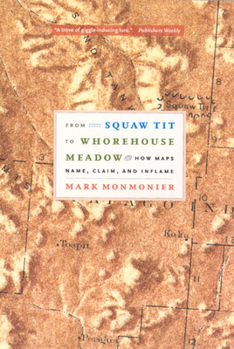From Squaw Tit to Whorehouse Meadow: How Maps Name, Claim, and Inflame
Select Format
Select Condition 
Book Overview
Brassiere Hills, Alaska. Mollys Nipple, Utah. Outhouse Draw, Nevada. In the early twentieth century, it was common for towns and geographical features to have salacious, bawdy, and even derogatory names. In the age before political correctness, mapmakers readily accepted any local preference for place names, prizing accurate representation over standards of decorum. Thus, summits such as Squaw Tit-which towered above valleys in Arizona, New Mexico, Nevada, and California-found their way into the cartographic annals. Later, when sanctions prohibited local use of racially, ethnically, and scatalogically offensive toponyms, town names like Jap Valley, California, were erased from the national and cultural map forever. From Squaw Tit to Whorehouse Meadow probes this little-known chapter in American cartographic history by considering the intersecting efforts to computerize mapmaking, standardize geographic names, and respond to public concern over ethnically offensive appellations. Interweaving cartographic history with tales of politics and power, celebrated geographer Mark Monmonier locates his story within the past and present struggles of mapmakers to create an orderly process for naming that avoids confusion, preserves history, and serves different political aims. Anchored by a diverse selection of naming controversies-in the United States, Canada, Cyprus, Israel, Palestine, and Antarctica; on the ocean floor and the surface of the moon; and in other parts of our solar system-From Squaw Tit to Whorehouse Meadow richly reveals the map's role as a mediated portrait of the cultural landscape. And unlike other books that consider place names, this is the first to reflect on both the real cartographic and political imbroglios they engender. From Squaw Tit to Whorehouse Meadow is Mark Monmonier at his finest: a learned analysis of a timely and controversial subject rendered accessible-and even entertaining-to the general reader.
Format:Paperback
Language:English
ISBN:0226534669
ISBN13:9780226534664
Release Date:September 2007
Publisher:University of Chicago Press
Length:230 Pages
Weight:0.75 lbs.
Dimensions:0.7" x 6.4" x 8.9"
Customer Reviews
1 rating
Tales of Toponyms
Published by Thriftbooks.com User , 18 years ago
No "Nigger" has been on the US map for fifty years, and most instances of "Squaw" and "Jap" were eliminated shortly thereafter, but we still have the occasional "Wop" or "Chink". You may not even know what a toponym is (it is simply a name for a place), but cartographers not only use toponyms, they try to get them right, and they don't mean to offend anyone, but sometimes they do. The offense isn't always ethnic; it might be international or personal or salacious. You might think that toponymy (the study of toponyms) would be a fairly dull academic endeavor, and surely this is the case most of the time. However, _From Squaw Tit to Whorehouse Meadow: How Maps Name, Claim, and Inflame_ (University of Chicago Press), professor of geography Mark Monmonier shows just how contentious map naming and renaming can be. The book is an academic reflection on problems humans make for themselves in their busy name-finding (and name-calling) efforts, but with its illustrations of problems in naming, it is also a greatly amusing book. It is hard to blame the original mapmakers. People attached names like Nigger Pond, Chinks Peak, or Squaw River because that is the way settlers talked. Then the mapmakers and surveyors came in, and "conscientiously but uncritically recorded local usage." The U.S. Board on Geographic Names handles requests to change objectionable names. In 1963, every cartographic instance of "nigger" was eliminated. Thus, "Niggerhead Point" which had appeared on a map of Port Bay in upstate New York could not stand. The solution for 1963 was to substitute the then current replacement term so that the feature became "Negrohead Point". Monmonier writes, "In the early 1960s, Negro had not yet acquired the distaste that led to its sequential replacement among more ethnically sensitive speakers, if not on maps, by _black_, _African American_, and _people of color_." It remains "Negrohead Point" on federal maps, but local New York agencies have simplified the issue, thankfully not changing it to "People of Color-Head Point" but to "Graves Point", perhaps because of a cemetery there. Sometimes the renaming is not that simple. The use of "squaw" is "the thorniest issue in applied toponymy." While there are those who say the term only means a Native American woman, many have argued that it is an ugly synonym for vagina which is then applied to women. There has been a proposal for another blanket change, from "Squaw" to "Moose", so that Maine now has a Moose Bosom. At least it still has a bosom. There are many other instances of naming naughtiness here. In Oregon is Whorehouse Meadows, a bawdy toponym that did record the historic instance of a field bordello. The Bureau of Land Management changed its maps to the silly name "Naughty Girl Meadows", but residents and historians agree that the original name is best. There are serious issues in Monmonier's book. A chapter covers the knotty problems, for instance, of toponyms in disputed





